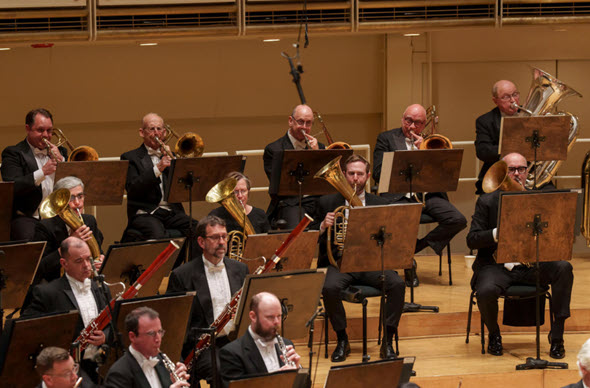A valedictory for percussion caps CSO tenure of composer in residence Jessie Montgomery

CSO principal percussionist Cynthia Yeh was the athletic soloist in the world premiere of Jessie Montgomery’s “Procession.” (Todd Rosenberg photos)
Review: Chicago Symphony Orchestra conducted by Manfred Honeck, May 30 at Orchestra Hall.
By Lawrence B. Johnson
A notably productive chapter in the Chicago Symphony Orchestra’s composer-in-residence program came to a splendid, and certainly resonant, close last weekend with the world premiere of Jessie Montgomery’s “Procession” for percussion and orchestra. It was nothing short of a bang-up success.
Unlike the two preceding residencies, each of which was shared by two composers, Montgomery’s tenure has been a solo endeavor, and she has carried out her duties as composer, mentor and curator of the CSO’s MusicNOW series with evident energy, zeal and engagement. The premiere of “Procession,” a concerto commissioned by the Chicago Symphony and written expressly for principal percussionist Cynthia Yeh, provided a fitting and impressive capstone to Montgomery’s stint as creative artist at Orchestra Hall.
“Procession,” laid out in five movements lasting about 20 minutes, is a doozy of a workout for the soloist, who in this unveiling scooted back and forth between percussion arrays behind the violins and at the front of the stage to the left of conductor Manfred Honeck. In program notes, Montgomery said her colorful and impulsive work was “inspired by the idea of how people organize and participate in variations of processionals — whether religious, political, celebratory, in marking achievements, births, deaths, war and fights for freedom…” While pomp and ceremony register in “Procession,” two other qualities struck this listener as preeminent: The work is distinctly American and its groove is essentially urban. What’s also unspoken, and to a modest fault, is the intimate role of the orchestra, which Montgomery has fashioned with unflagging imagination and brilliance.
Oddly, the concert program book did not offer movement titles or even tempos. Just “Procession.” Indeed, it proceeds episode to closely linked episode, beginning with a fierce flourish of drumming, a sort of praeludium, that ended with Yeh scampering from the back of the band to stage front and a complete turn of temperament in the voices of vibraphone and glockenspiel — alternating with yet more drumming. But the mellow tone of the vibraphone also brought the whole feverish business its one real pause, in something of a musing cadenza that surely allowed the audience’s collective heart rate to calm a bit.
Through much of the work, jazz syncopations speak of uptown Americana. For the bounding soloist, it’s an unstintingly complex assignment, which Yeh met with the absolute mastery, the same bravura flair that CSO patrons have come to know well. It’s also a virtually nonstop role, physically robust, athletic.
Montgomery has cast the percussion within a smartly integrated orchestration that exploits, often quite subtly, a scheme of call and response. In the midst of it all falls a kind of intermezzo, an old-fashioned fife-and-drum riff in which Yeh’s military drumming was matched with the piccolo virtuosity of Jennifer Gunn and Yevgeny Faniuk. In the end, the composer offers an enigma: a winding down of the solo drumming, as if in final repose. Which procession in life closes thus? It is the fading of a last march, no doubt.
The 20 minutes of “Procession” accounted for the concert’s first part, but hardly half. The second part brought the 65 minutes of Bruckner’s Symphony No. 7 in E major. What a drastic swing away from the Mahler Second of the week before. A friend who is a Mahler enthusiast but has issues with Bruckner’s similarly sprawling symphonies (albeit similar in no other respect), once recoiled from the idea of hearing another Bruckner symphony with this: “Let me know when they get to the scherzo. I’ll be in the bar.”
In more philosophical and embracing terms, the fundamental difference in the epic works of Bruckner and Mahler has been characterized as Mahler searching for meaning and for God whereas Bruckner starts with the conviction of both. There are no shadows in Bruckner’s symphonies, only light and affirmation. Like Bach, all the music he ever wrote was dedicated to the glory of God. Bruckner built cathedrals in sound. This is pointedly true of the Seventh Symphony, and Honeck led a magisterial performance — patient, expansive, splendorous.
While the typically vast Seventh may give the impression of extensive literal repetition, but Honeck’s sensitive inflections dispatched that simplistic notion. Like Bruckner’s other mature works at least from the Fourth Symphony forward through the unfinished Ninth, his refined craftsmanship and manipulative skill suggest Beethoven as viewed through the prism of Schubert. Bruckner requires submission, or let’s say immersion; one must go with the broad, aspiring flow.
That was the beauty of Honeck’s account and the Chicago Symphony’s luxuriant playing: indulgent tempos, clear voicing, radiant sonorities on every side, from strings and woodwinds to the brasses and a complement of five French horns and four tenor-voiced hybrid instruments devised by Richard Wagner and thus called Wagner tubas. A joyful noise this was, indeed, tremendous and ethereal.




